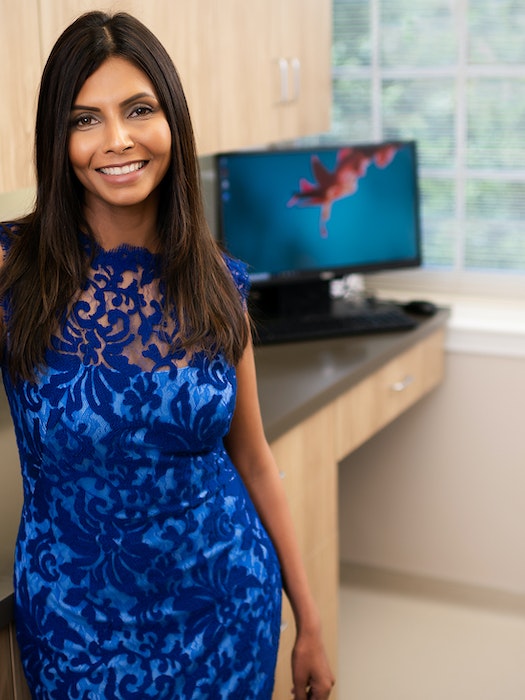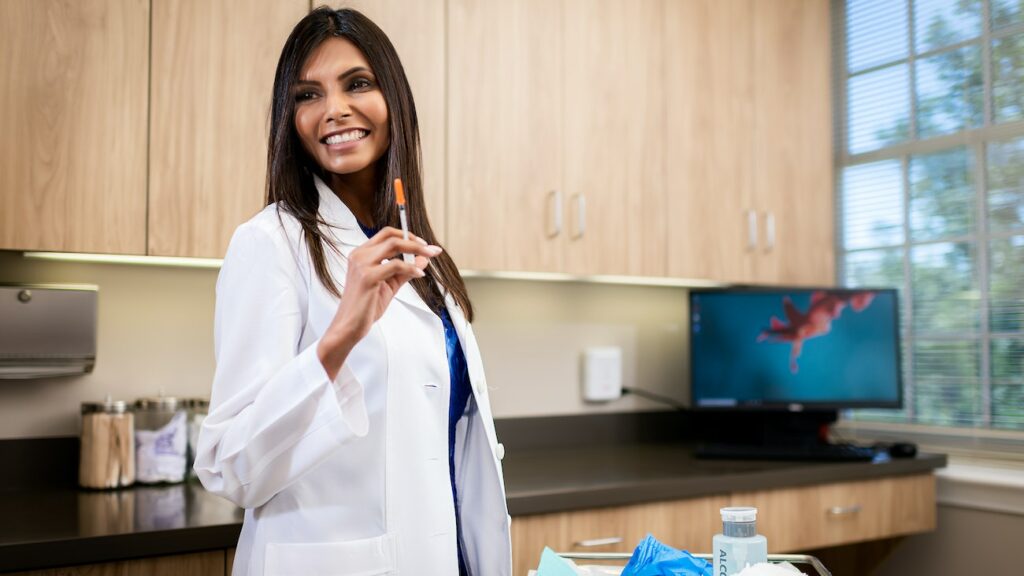Dallas Dermatologist Dr. Kejal Shah Reveals the Most Overlooked Aspect of Skincare
Thespotlyte | August 03, 23

he’s jetlagged from a trip to Italy, but you’d never know it. It’s only been a few hours since Kejal Shah, MD, board-certified dermatologist in Dallas, TX, stepped off a plane and back into her office at the Cooper Clinic®. While chatting with us, Dr. Shah looks glamorous and well-rested.
Originally from Mumbai, India, Dr. Shah was raised surrounded by physicians. “I grew up in a family of doctors,” says Dr. Shah. “My dad is a pediatrician and my uncle is a radiologist.” Her brother is also a dentist. Medicine was always a large part of Dr. Shah’s life, so it felt like a natural career path for her. She first enrolled in Topiwala National Medical College℠ and Nair Hospital℠, and then completed her dermatology residency in India.
Eventually, Dr. Shah immigrated to the United States, and completed another dermatology residency at Baylor University Medical Center® in Dallas. “I was very fortunate to receive such extensive training in dermatology,” says Dr. Shah. Ahead, we discuss everything from Dr. Shah’s favorite in-office treatments to the Dallas skincare trends that she’s been noticing over the past few years (spoiler: her patients are a lot younger these days…).
Spotlyte: How did you end up in the field of dermatology?
Dr. Kejal Shah: I knew very early on that I wanted to be a doctor, but I just didn’t know what kind. In medical school, when I was exposed to the field of dermatology, I instantly fell in love with this specialty. It was very fascinating for me to see how much your skin can affect your health, and that many internal diseases can show clinical manifestation on your skin. Sometimes, you can diagnose systemic diseases by simply looking at the skin. Dermatology is a fascinating field, and I value the opportunity to develop a long-term relationship with my patients.

Spotlyte: Did growing up in Mumbai, India, influence your perspective on skincare at all?
KS: Yes. With my dermatology training in India, I feel very comfortable treating skin of color. There are certain skin problems — such as melasma, hyperpigmentation, and keloid scars — that darker skin is more prone to having. If these are not treated appropriately, worse problems can develop. One has to be very careful with treating skin of color, because any products or procedures that can irritate the skin can easily cause hyperpigmentation and scarring.
Spotlyte: What are the biggest skin challenges your patients face?
KS: Every patient is different and I tailor my recommendations and treatment [regimen] according to my patients’ individual needs. There are some patients who come to me for a skin check and have a considerable amount of sun damage [because] they are not using sunscreen. Convincing [patients] to wear daily sunscreen is one of the biggest challenges I face each day.
Another challenge I face is when a patient comes to me requesting filler [in a particular area] or an aesthetic procedure just because their friend has had it. I like to have open and frank discussions with my patients to decide together what would work best for them, because every face is different, each individual’s skin is different, and not all fillers or procedures [will] provide the same results.
[Editor’s note: Injectable filler is a temporary treatment that adds volume to areas of the face such as the lips, cheeks, and laugh lines. Like any medical treatment, it has potential risks and side effects. Be sure to talk to a licensed provider to see if it’s right for you. Have more questions? Chat with our team of trained aesthetic specialists now.]

Spotlyte: Have you noticed any trends or popular treatments happening in Dallas at the moment?
KS: Dallas is one of the leading markets for neuromodulators [also known as injectable wrinkle reducers] and fillers. Neuromodulators can help reduce [the appearance of] moderate to severe lines on the forehead and around the eyes. Injectable fillers can add volume. Also, around age 30, our lips gradually start to deflate, lose their volume and shape. So, patients now want [more] fillers in their lips. But oversized lip augmentation is not in vogue anymore. I am seeing patients moving toward [a more subtle] philosophy.
[Editor’s note: Injectable wrinkle reducers are used to temporarily smooth the look of moderate to severe wrinkles in certain areas of the face such as the forehead, frown lines, and crow’s feet. They should not be used more frequently than every three months. Like any medical treatment, they have potential risks and side effects. Be sure to talk to a licensed provider to see if they’re right for you. Have more questions? Chat with our team of trained aesthetics specialists now.]
Another trend is the increasing number of men requesting consultations and treatment for reducing wrinkles [and] facial rejuvenation. They’re looking for non-invasive procedures with minimal downtime.
Spotlyte: Are you noticing any trends when it comes to the age of your patients?
KS: The average age at which patients begin getting aesthetic treatments has gotten lower.

Spotlyte: Do you do a lot of injectables in your office?
KS: I see patients with various dermatologic needs that include preventive, general, surgical, and cosmetic dermatology. A considerable amount of my practice includes injectables, such as neuromodulators and fillers. It is an amazing experience to see a patient [be happy with their results]. To be a part of this is satisfying and makes years of medical training worthwhile.
Spotlyte: What’s a typical day for you in your office?
KS: My typical clinic day is filled with a variety of patients. I see patients for skin cancer screening and treatment, and general dermatology, such as acne, eczema, rashes, and warts. Part of my day is filled with procedures such as injectables (like fillers and neuromodulators), laser resurfacing, and chemical peels. In between patients, I am signing charts or sending off prescriptions.
Spotlyte: What in-office treatments have you tried yourself?
KS: I get laser treatment once a year for facial rejuvenation. I also do peels on my face and neck, which is safe for my skin type.
Spotlyte: Do you get any injectables?
KS: Yes, I get treated with neuromodulators for my forehead creases and crow’s feet about two to three times a year. I have used filler on my cheeks. I started [getting] neuromodulators and fillers in my early thirties.
Spotlyte: What do you feel is the most overlooked aspect of skincare?
KS: Beautiful, healthy, attractive skin needs a healthy lifestyle. I believe taking care of your skin is an integral part of your overall health.

Spotlyte: What’s your skincare routine like?
KS: I believe in a skincare routine that protects my skin from ultraviolet radiation and helps to restore and maintain skin health for a vibrant, youthful appearance. The three most important components are sunscreen, a topical antioxidant such as vitamin C, and a retinoid.
[Editor’s note: Retinol shouldn’t be used by those who are pregnant, considering getting pregnant, or nursing. Please consult with your doctor before use.]
In the morning, I clean my face with gentle cleanser and then I apply a topical antioxidant to protect my skin from sun and pollution. One of my favorites is Isdin® Flavo-C Ultraglican®. This formulation is sealed in a glass ampoule to ensure stability and potency. It contains vitamin C and hyaluronic acid to help improve the appearance of fine lines and wrinkles. Then, I apply the Alastin Skincare® Restorative Skin Complex with TriHex Technology®. It helps support the skin’s natural ability to produce new, healthy elastin and collagen, and it helps protect the skin from further damage. Last is my daily sunscreen. I do not leave my house without applying a zinc-based sunscreen. My favorite is the Elta MD® UV Daily Broad-Spectrum SPF 40 Tinted ($31).
Spotlyte: What about your nighttime routine?
KS: In the evenings, I wash my face with a gentle exfoliating cleanser with glycolic acid to remove dry skin buildup. Following that, I apply tretinoin or Alastin Renewal Retinol. It helps with collagen production, repairing the skin, evening out skin texture, and improving fine lines and wrinkles while sleeping.
Spotlyte: What do you do for fun outside of work?
KS: Outside of dermatology, [I love] spending time with my three children and husband, who is also a physician, as well as bike riding with my son, traveling, fitness, and yoga. I am a certified yoga instructor. I am not teaching yoga yet, but I hope one day I will. It’s truly a body, mind, and soul connection. Yoga has taught me how to stay grounded, calm, and focused in my personal life as well as in my work life.
Spotlyte: Speaking of children, what’s one skincare step you hope they’ll never forget?
KS: We have three children, two teenage girls, and one little boy. If they only do one thing, I would [hope] it’s to protect their skin against harmful ultraviolet light from the sun by seeking shade when possible and applying daily sunscreen.
Product prices may vary from the time this article was written.
Allergan® may receive commissions for purchases made through links in this article.






